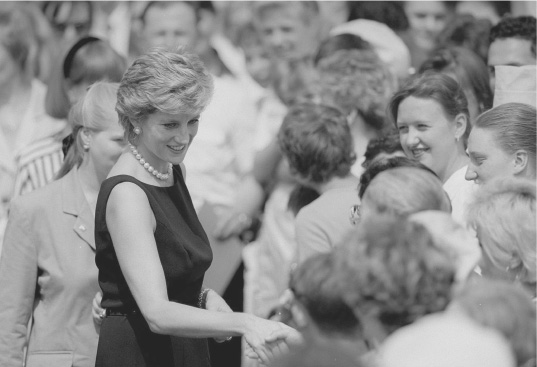

THE DEATH OF PRINCESS DIANA AND THE WEAKENING OF THE NATION’S STIFF UPPER LIP
A page from the Dodi and Diana condolence book at Harrods is depicted in the fourth plate section.
In the early hours of 31 August 1997, Diana, Princess of Wales, then just thirty-six, died from injuries sustained in a car crash in central Paris. Also killed in the accident were her boyfriend, Dodi Fayed – son of the Egyptian entrepreneur Mohamed Al-Fayed, owner of Harrods department store – and the car’s driver, Henri Paul, deputy head of security at the al-Fayed-owned Paris Ritz, where Diana and Dodi had been staying. Diana’s life had been a heady mixture of aristocratic privilege and modern celebrity glitz, compassion for the less fortunate and media savviness, mass adulation and personal unhappiness. Her death sparked an outpouring of public emotion so removed from the self-control displayed by her former mother-in-law Queen Elizabeth II and her generation that it seemed as if a social revolution was under way. Some believed the monarchy itself was briefly endangered.
The fact that her fifteen-year marriage to the Prince of Wales had ended in divorce in 1996 had done little to diminish Princess Diana’s public profile, either in Britain, where as the mother of Princes William and Harry she could hardly fail to be newsworthy, or in the rest of the world, where she remained a fashion icon on a scale surpassing that achieved by any Englishwoman in history. She had developed from the shy, nineteen-year-old daughter of an earl who married the Prince of Wales in 1981 into a loving mother, a dangerously weight-conscious bulimic and an international superstar. Technically, she had not been the hardest-working member of the royal family, but her stylishness and natural sympathy for others – whether embracing Aids sufferers or campaigning for a worldwide ban of landmines – gave to her engagements and charitable undertakings a frisson that those merely doing their duty could not match.
With the unravelling of her marriage, she launched a media campaign to both put her side of the story and discredit the Prince of Wales, first by providing private briefings to a friendly biographer, Andrew Morton, who turned out the best-selling Diana – Her True Story, and then, even more sensationally, by questioning whether her former husband was up to the job of kingship in a carefully choreographed television interview. In the broadcast, she cast herself as a ‘queen in people’s hearts’. It was a theme that the newly elected prime minister, Tony Blair, embellished when giving his public reaction to her death: ‘People everywhere, not just here in Britain, kept faith with Princess Diana. They liked her, they loved her, they regarded her as one of the people. She was the People’s Princess and that is how she will stay, how she will remain in our hearts and our memories for ever.’
The royal family was holidaying at Balmoral when the tragedy struck. The queen considered it her first duty to remain on the Scottish estate with her bereaved grandchildren, away from the public glare. The public mood elsewhere in the kingdom switched from grief at the cruel death of a beautiful and well-intentioned young woman to anger at the queen’s failure to venture down south and visibly join in the emotional display. Realizing that private reflection was not what the public wanted, Blair was among those who persuaded the queen to make a hasty return to her capital, broadcast an appropriate tribute and ensure that Diana received a full public funeral. These late interventions did much to retrieve the House of Windsor’s faltering standing.
Even so, suspicion of ‘the Establishment’ manifested itself, for a while, in the widespread credence given to a bizarre conspiracy theory in which the accident – caused in reality by a drunken chauffeur trying to shake off motorcycle photographers – had been an assassination carried out by Britain’s security services. Resentment was also apparent at the funeral in the burst of applause, first outside and then inside Westminster Abbey, when Diana’s brother Earl Spencer delivered a eulogy critical of the royal family’s perceived lack of interpersonal skills.
Well over one million mourners gathered in Hyde Park or lined the route of Diana’s coffin as it made its way to the Spencer family seat of Althorp in Northamptonshire. Across the world, an estimated 2.5 billion people watched the funeral on television. A sea of floral tributes was laid beyond the gates of Kensington Palace, Diana’s former home. Candles were placed next to makeshift shrines, illustrated with cuttings of the princess from glossy magazines. Queues formed to sign books of condolence at St James’s Palace and at other points around the country. The Britain of self-control, of a stiff upper lip, of quiet Protestant understatement appeared to have been replaced by a temperament previously associated with Catholic Latin America. While many rejoiced that the emotionally repressed national caricature was giving way to one newly confident in expressing its feelings, others were aghast at what appeared, rather, to be the symptoms of a collective nervous breakdown.
The days of public mourning for Diana have become an indelible moment of shared national consciousness, like VE-Day or the England football team’s 1966 World Cup victory. Measuring the extent to which the event shaped, or exemplified, changes in British society perhaps needs a longer perspective. The style of the public tribute was unprecedented, but its impressive scale needs putting in context. Vast crowds turned out to pay their respects at the state funeral of Field Marshal Earl Haig in 1928, yet his reputation proceeded to diminish almost continuously over the following half-century. At any rate, the damage done to the mystique of monarchy – which, after all, had once been part of Diana’s own appeal – was certainly not apparent when, in 2005, joyful nationwide celebrations marked the Queen’s Golden Jubilee.

Diana attracted huge crowds all over the world. These admirers are Russian.